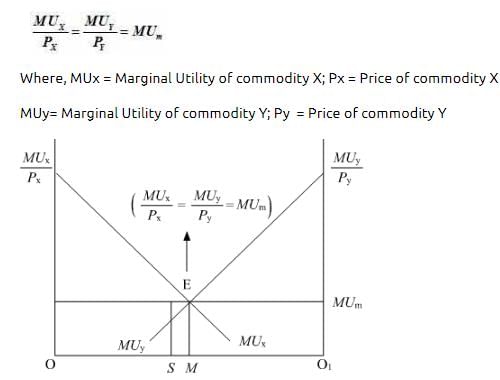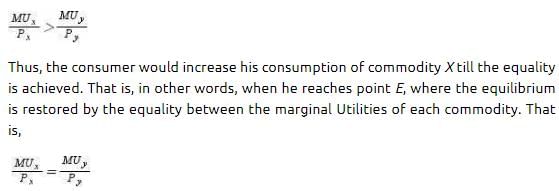Commerce Exam > Commerce Questions > Consumer equillibrium in two commodity case.p...
Start Learning for Free
Consumer equillibrium in two commodity case.pls explain ?
Verified Answer
Consumer equillibrium in two commodity case.pls explain ?
In case of two commodities, the Consumer's Equilibrium is given in accordance with the Law of Equi-Marginal Utility.
Law of Equi-Marginal Utility states that a consumer allocates his expenditure on the two commodities in such a manner that the utility derived from each additional unit of the rupee spent on each of the commodities is equal. That is,

In the diagram, OO1 represents the total income of a consumer. MUx and MUy represent the Marginal Utility curves of commodity X and commodity Y, respectively. Equilibrium is established at point E. At this point, OM amount of income is spent on commodity X and the remaining amount of income MO1 is spent on commodity Y. Suppose instead of point M, the consumer is at point S, where he spends OS amount of income on commodity X and SO1 amount of income on commodity Y. At point S, however;

 This question is part of UPSC exam. View all Commerce courses
This question is part of UPSC exam. View all Commerce courses
Most Upvoted Answer
Consumer equillibrium in two commodity case.pls explain ?
Consumer Equilibrium in Two Commodity Case
Consumer equilibrium in a two-commodity case refers to a situation where a consumer maximizes their satisfaction or utility subject to their budget constraint. In other words, it is the point at which a consumer allocates their income between two goods to derive the maximum level of satisfaction.
Budget Constraint:
The consumer's budget constraint is determined by their income and the prices of the two commodities. Let's say the consumer's income is denoted by M, and the prices of the two commodities are denoted by P1 and P2, respectively. The budget constraint can be expressed as:
M = P1Q1 + P2Q2
Where Q1 and Q2 represent the quantities of the two commodities consumed by the consumer.
Consumer Preferences:
To understand consumer equilibrium, we need to consider the consumer's preferences. Preferences determine the consumer's level of satisfaction or utility derived from consuming different combinations of the two commodities. The consumer's preferences are typically represented by indifference curves.
Indifference Curves:
Indifference curves represent various combinations of the two commodities that provide the consumer with the same level of satisfaction. These curves are downward sloping due to the principle of diminishing marginal rate of substitution, which suggests that as a consumer consumes more of one commodity, they are willing to give up less of the other commodity to maintain the same level of satisfaction.
Attaining Consumer Equilibrium:
To attain consumer equilibrium, the consumer needs to allocate their income in a way that maximizes their satisfaction. This is achieved at the point where the budget constraint is tangent to the highest possible indifference curve.
Key Points:
1. Consumer equilibrium is achieved when the consumer maximizes their satisfaction or utility given their budget constraint.
2. The budget constraint is determined by the consumer's income and the prices of the two commodities.
3. Indifference curves represent the consumer's preferences and are downward sloping due to the principle of diminishing marginal rate of substitution.
4. Consumer equilibrium is attained when the budget constraint is tangent to the highest possible indifference curve.
Visual Representation:
To visually represent consumer equilibrium in a two-commodity case, we can plot the budget constraint and indifference curves on a graph. The point of tangency between the budget constraint and the highest possible indifference curve represents the consumer's equilibrium position.
By understanding consumer equilibrium in a two-commodity case, economists can analyze consumer behavior and make predictions about how changes in income or prices will impact consumer choices and welfare.
Consumer equilibrium in a two-commodity case refers to a situation where a consumer maximizes their satisfaction or utility subject to their budget constraint. In other words, it is the point at which a consumer allocates their income between two goods to derive the maximum level of satisfaction.
Budget Constraint:
The consumer's budget constraint is determined by their income and the prices of the two commodities. Let's say the consumer's income is denoted by M, and the prices of the two commodities are denoted by P1 and P2, respectively. The budget constraint can be expressed as:
M = P1Q1 + P2Q2
Where Q1 and Q2 represent the quantities of the two commodities consumed by the consumer.
Consumer Preferences:
To understand consumer equilibrium, we need to consider the consumer's preferences. Preferences determine the consumer's level of satisfaction or utility derived from consuming different combinations of the two commodities. The consumer's preferences are typically represented by indifference curves.
Indifference Curves:
Indifference curves represent various combinations of the two commodities that provide the consumer with the same level of satisfaction. These curves are downward sloping due to the principle of diminishing marginal rate of substitution, which suggests that as a consumer consumes more of one commodity, they are willing to give up less of the other commodity to maintain the same level of satisfaction.
Attaining Consumer Equilibrium:
To attain consumer equilibrium, the consumer needs to allocate their income in a way that maximizes their satisfaction. This is achieved at the point where the budget constraint is tangent to the highest possible indifference curve.
Key Points:
1. Consumer equilibrium is achieved when the consumer maximizes their satisfaction or utility given their budget constraint.
2. The budget constraint is determined by the consumer's income and the prices of the two commodities.
3. Indifference curves represent the consumer's preferences and are downward sloping due to the principle of diminishing marginal rate of substitution.
4. Consumer equilibrium is attained when the budget constraint is tangent to the highest possible indifference curve.
Visual Representation:
To visually represent consumer equilibrium in a two-commodity case, we can plot the budget constraint and indifference curves on a graph. The point of tangency between the budget constraint and the highest possible indifference curve represents the consumer's equilibrium position.
By understanding consumer equilibrium in a two-commodity case, economists can analyze consumer behavior and make predictions about how changes in income or prices will impact consumer choices and welfare.

|
Explore Courses for Commerce exam
|

|
Question Description
Consumer equillibrium in two commodity case.pls explain ? for Commerce 2025 is part of Commerce preparation. The Question and answers have been prepared according to the Commerce exam syllabus. Information about Consumer equillibrium in two commodity case.pls explain ? covers all topics & solutions for Commerce 2025 Exam. Find important definitions, questions, meanings, examples, exercises and tests below for Consumer equillibrium in two commodity case.pls explain ?.
Consumer equillibrium in two commodity case.pls explain ? for Commerce 2025 is part of Commerce preparation. The Question and answers have been prepared according to the Commerce exam syllabus. Information about Consumer equillibrium in two commodity case.pls explain ? covers all topics & solutions for Commerce 2025 Exam. Find important definitions, questions, meanings, examples, exercises and tests below for Consumer equillibrium in two commodity case.pls explain ?.
Solutions for Consumer equillibrium in two commodity case.pls explain ? in English & in Hindi are available as part of our courses for Commerce.
Download more important topics, notes, lectures and mock test series for Commerce Exam by signing up for free.
Here you can find the meaning of Consumer equillibrium in two commodity case.pls explain ? defined & explained in the simplest way possible. Besides giving the explanation of
Consumer equillibrium in two commodity case.pls explain ?, a detailed solution for Consumer equillibrium in two commodity case.pls explain ? has been provided alongside types of Consumer equillibrium in two commodity case.pls explain ? theory, EduRev gives you an
ample number of questions to practice Consumer equillibrium in two commodity case.pls explain ? tests, examples and also practice Commerce tests.

|
Explore Courses for Commerce exam
|

|
Signup for Free!
Signup to see your scores go up within 7 days! Learn & Practice with 1000+ FREE Notes, Videos & Tests.


















